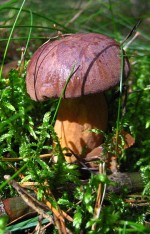 He bay-brown bolete grows singly or in scattered groups from summer through autumn under coniferous or deciduous trees of Europe and North America. It is especially partial to white pine, spruce, hemlock and beech, and can grow on decaying stumps or in the soil where it may be hidden by vegetation or tree litter. The mushroom stands 3.25 to 6 inches tall with a cap 2-6 inches across. The shiny bay-brown cap goes from convex to flat and has a velvety surface that becomes sticky and greasy-looking in wet weather. The tubes and pores are white to yellowish olive and the pores turn blue or green if touched. The pale brown stem is ½ to 1 ½ inches across with yellow to brown reticulation that create a woody appearance. The spores are olive brown.
He bay-brown bolete grows singly or in scattered groups from summer through autumn under coniferous or deciduous trees of Europe and North America. It is especially partial to white pine, spruce, hemlock and beech, and can grow on decaying stumps or in the soil where it may be hidden by vegetation or tree litter. The mushroom stands 3.25 to 6 inches tall with a cap 2-6 inches across. The shiny bay-brown cap goes from convex to flat and has a velvety surface that becomes sticky and greasy-looking in wet weather. The tubes and pores are white to yellowish olive and the pores turn blue or green if touched. The pale brown stem is ½ to 1 ½ inches across with yellow to brown reticulation that create a woody appearance. The spores are olive brown.
The bay-brown bolete has a fruity aroma and sweet flavor and is considered a desirable edible mushroom. The blue color that results from touching the flesh can be off-putting but it is harmless and will disappear with cooking. The mushrooms should be collected when dry, the stems discarded and the caps wiped rather than washed because of their tendency to absorb water. The caps can be frozen, dried, pickled, cooked, or eaten raw. They are good in sauces and soups, and make a good accompaniment to meats and fish when sautéed in butter.
Photo Credit: By Ralf Roletschek (talk) – Fahrradtechnik auf fahrradmonteur.de – Own work, GFDL 1.2, https://commons.wikimedia.org/w/index.php?curid=11410629